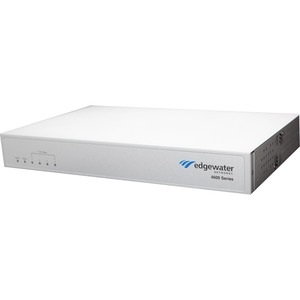
Service providers and enterprise organizations use the EdgeMarc 4601 Enterprise Session Border Controller to connect IP and TDM based PBXs to SIP trunking services.
Introduction
The EdgeMarc 4601 automatically manipulates SIP messages and features advanced inspection capabilities that enables it to be deployed in many different environments with a wide range of PBXs and SIP trunking services. It is the ideal platform for service providers and enterprise organizations for use in SIP trunking, hosted VoIP and other converged services.
Security and Connectivity
SIP-aware NAT/firewall. SIP protocol harmonization: adjustments needed to connect IP and TDM PBXs to service provider SIP trunks. SIP registration
proxy for service provider and/or PBX
High Quality Voice
Traffic management/QoS including prioritization, traffic shaping, CBWFQ and diffserv marking. Call Admission Control. Troubleshooting. Passive call quality monitoring. VoIP test call agent.
Simplified Installation
Supports multiple PBX connection types- PRI or IP Simplified GUI with PBX specific pull down menu
Broad Interoperability
Comprehensive list of PBX manufacturers and SIP trunking services. Consistent logical interface for the service provider regardless of PBX type. Interoperable with Microsoft Lync Server.
Note:
- The full product specifications below are from the manufacturer and may contain information related to other package quantities that will not apply to the product that you are reviewing. Please confirm the actual content and/or package quantity from the main product specifications page.
- These specifications may represent the entire product series/model/line to which this product belongs with specific configuration differences between the individual products stated.
- These specifications may have been copied from the same product in other region/country in which case there might be minor differences in region-specific data such as Input Voltage, Terms of Warranty etc.
Interfaces - T1 WAN:
- Up to 4 ports
- ESF/D4 Framing
- B8ZS/AMI Line Coding
- 0, -7, -15db Line Build Out
- RJ45 Connector
- PPP
- PPPoFR
- MLPPP
- MLPPPoFR
- Frame Relay
- HDLC/cHDLC
- Independent Clocking (per port)
- Up to 4 ports
- Double-frame, Double-frame CRC, Multi-frame, Multi-frame CRC Framing
- Unframed Support
- HDB3 Line Coding
- RJ-45, 120ohm balanced Connector
- PPP
- PPPoFR
- MLPPP
- MLPPPoFR
- Frame Relay
- HDLC/cHDLC
- 1 x 10/100 Mbps
- Auto Sensing
- RJ-45
- Half or Full Duplex
- PPoE
- 4 x 10/100 Mbps
- Auto Sensing
- RJ-45
- Half or Full Duplex
- Managed VLAN
Console Connector: DB9 Male
Power, Dimensions and Certifications:
- Height: 1 .7”, Width: 13”, Depth: 8”
- Weight: 2 lbs
- Power: External Brick (AC)- 12V, 3.0A
- Power Consumption: 32W (Maximum)
- Certifications: UL, CE, FCC Part 15, FCC Part 68, Industry of Canada, CB, RoHS
- Web GUI
- CLI
- HTTP, HTTPS
- SSH, Telnet
- SNMP v1, v3
- TCPdump, Traceroute, Ping, Syslog
- Configuration backup/restore
- Remote Upgrades (FTP)
- Supports IPv4 and IPv6 addressing and services
- DHCP server
- Local TFTP/FTP server
- Automatic TFTP/FTP download on restart
- Call pre-emption for priority calls
- Class-based queuing
- Prioritization on IP
- Prioritization on VoIP Protocol
- Traffic shaping
- Guaranteed bandwidth
- Upstream bandwidth management
- Downstream bandwidth management
- VoIP call admission control
- Diffserv marking
- Diffserv policing
- IP routing
- Secondary address/subinterface support
- VLAN - 802.1Q (up to 16)
- Relative Humidity: 10% to 90%
- SIP ALG/B2BUA
- H.323 ALG
- NAT for SIP
- NAT for H.323
- Survivability (SIP) - Available
- SIP registration pacing
- SIP registration proxy
- Softswitch redundancy
- Proxy mode
- Multi-homed proxy mode
- Transparent proxy mode
- EdgeView Plug & Dial Compatible
- Dynamic VoIP clients list
- SIP RFC 3261
- SIP RFC 2327
- SIP RFC 3263
- SIP RFC 2833 (Passthrough and
- PRI only)
- H.323 version 4
- H.225.0v5
- H.245.0v10
- VoIP Test Call Agent
- Password encryption for SIP User Agent password (protect EdgeMarc and SIP UA credentials)
- Stateful packet inspection firewall
- VoIP protocol aware firewall
- Dynamic network address translation
- Static network address translation
- Port address translation
- Denial of Service protection - SYN flood
- Denial of Service protection - UDP flood
- Denial of Service protection - ICMP flood
- Denial of Service protection - Fragment flood
- IPSec
- IKE key management
- 3DES
- AES
- SHA-1
- MD-5
2 PRI Links (T1 only, Maximum):
PRI Codec:
- G711ulaw
- G711alaw
- G729a
- NI2
- ESS4 (aka 4ESS)
- ESS5 (aka 5ESS)
- DMS100
- Euro-ISDN (E1 PRI)
- HK-ISDN (T1 PRI)
- NI2
- 4ESS
- 5ESS
- DMS100
- Euro-ISDN (E1 PRI)
- HK-ISDN (T1 PRI)
- G711ulaw
- G711alaw
- G729a
- Ground start
- Loop start
- GR-303 Ground start
- GR-303 Loop start
- Ground Start(SAS)
- Loop Start(SAS)
- E&M
- FXO-GR303 ground start
- FXO-GR303 loop start
- E&M
- Out of Band DTMF (RFC 2833)
- Echo Cancellation (User Side)
- Gain Control (User Side)
- Applications-PBX Trunking
- Applications- PSTN Failover
- Per call statistics
- LAN side measurements
- WAN side measurements
- Mean Opinion Score (MOS)
- Bad MOS score alarms
- Below threshold MOS counters
- Degradation in MOS due to network impairments
- Jitter
- Packet loss
- Consecutive lost packets
- Total # of RTP packets received
- Sum of received & expected packets
- Out of sequence packets
- Average packet loss burst length
- Estimated jitter buffer delay
- Estimated jitter buffer packet discard rate
- Probability that degradation is due to LAN congestion
- Probability that degradation is due to Router congestion
- Probability that degradation is due to access link congestion
- Probability that degradation is due to diverse routing
- Probability that degradation is due to unreliable link
- 89,555 hours
- Hardware: 5 years
- Software: 1 year